3115110 タイ/カチュー(水草) 整理かご 楕円 S・M・L 3サイズ
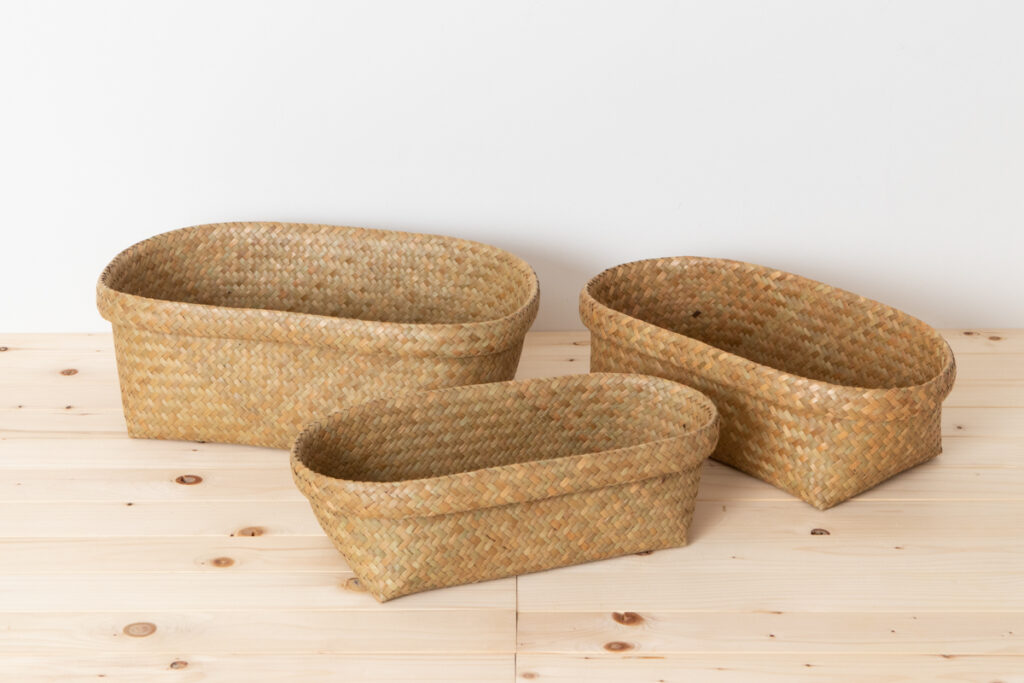
こちらはタイ語で「カチュー」と呼ばれる沼地周辺に自生する草で
編まれたかごです。
茎の部分を根から切り取り、乾燥させて平たくした状態のものを編み込んでいきます。茎は春(5月ごろ)から夏(8月ごろ)にかけて収穫されます。
大きいサイズのかごには長めの茎が必要とされるため、
少し収穫を遅らせてさらに成長するのを待ってから刈り採ることもあります。
作り手は地域により異なりますが、編む技術に長けた人が先生となり周りの人に指導しながら製作するグループや、家族3世代で編む人たちなど。
村ごとにだいたい4〜5人のグループで作られていることが多いようです。
ほとんどの方にとってかご作りは専業ではなく、稲作など農業の合間に作られることが多く、編み手は高齢世代が多いのが現状です。
若い世代の編み手が少ないながらも、今、改めてタイ国内でも、こうした自然素材製品の良さが見直され、若い人たちがかごを手に取るようになってきているとのこと。
こちらのページでは、「カチュー」製、楕円型の整理かご
「S、M、L」3サイズをご紹介します。

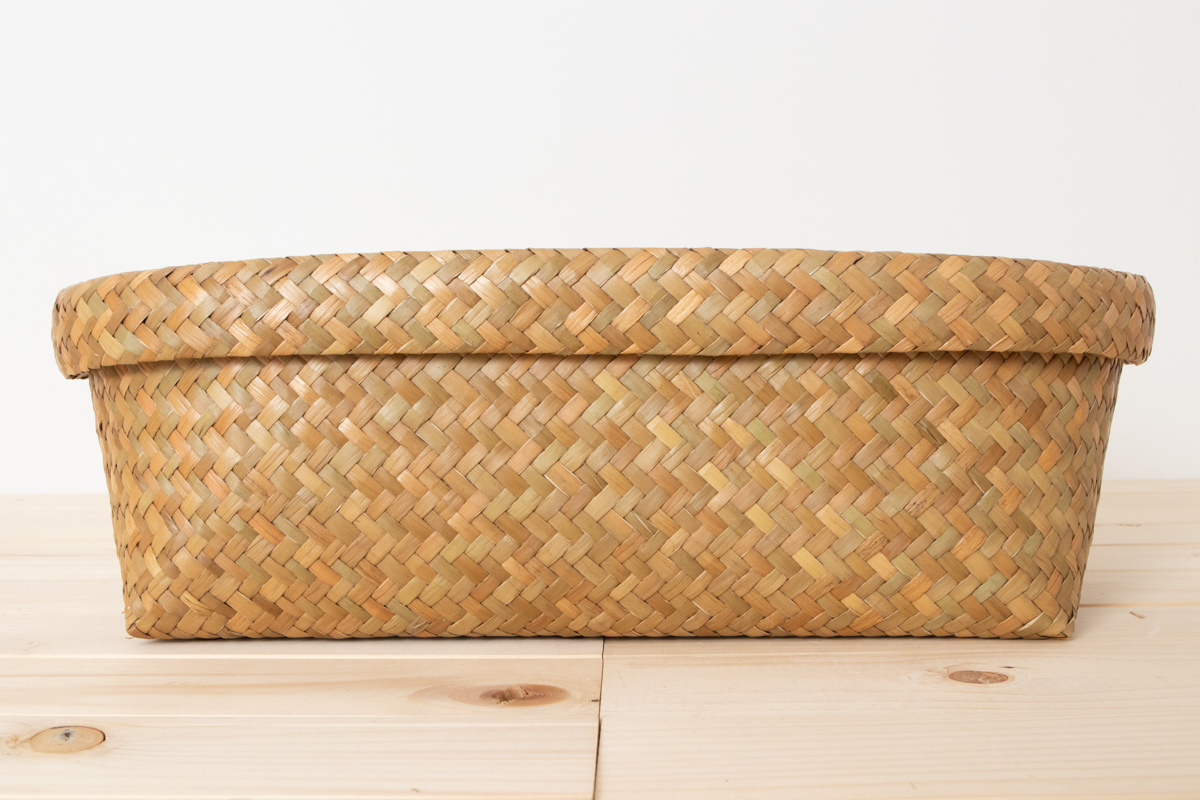
かご側面の編み目は、日本で「あじろ編み」と呼ばれる編み方と同じです。 
平たくした茎を交互に編み組んでいき、一枚の「ござ」ぐらいの大きさに仕上げたものを、かごの形に成形していきます。 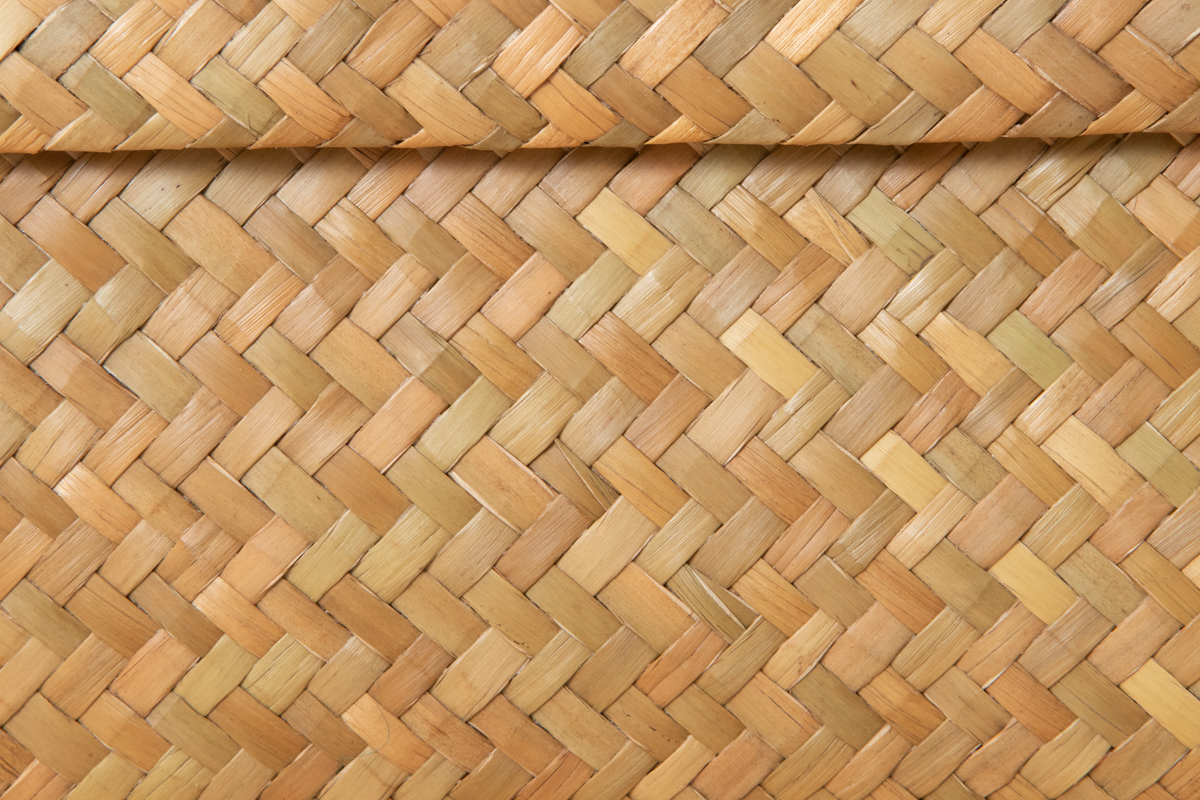
水辺から伐り採ったカチューの茎は、粘土質の泥を塗り込んで3〜5日ほど天日干しされます。そうすることで、素材に粘りと湿り気を持たせて乾燥による割れを防ぐことができ、素材としての強度が増すとのこと。 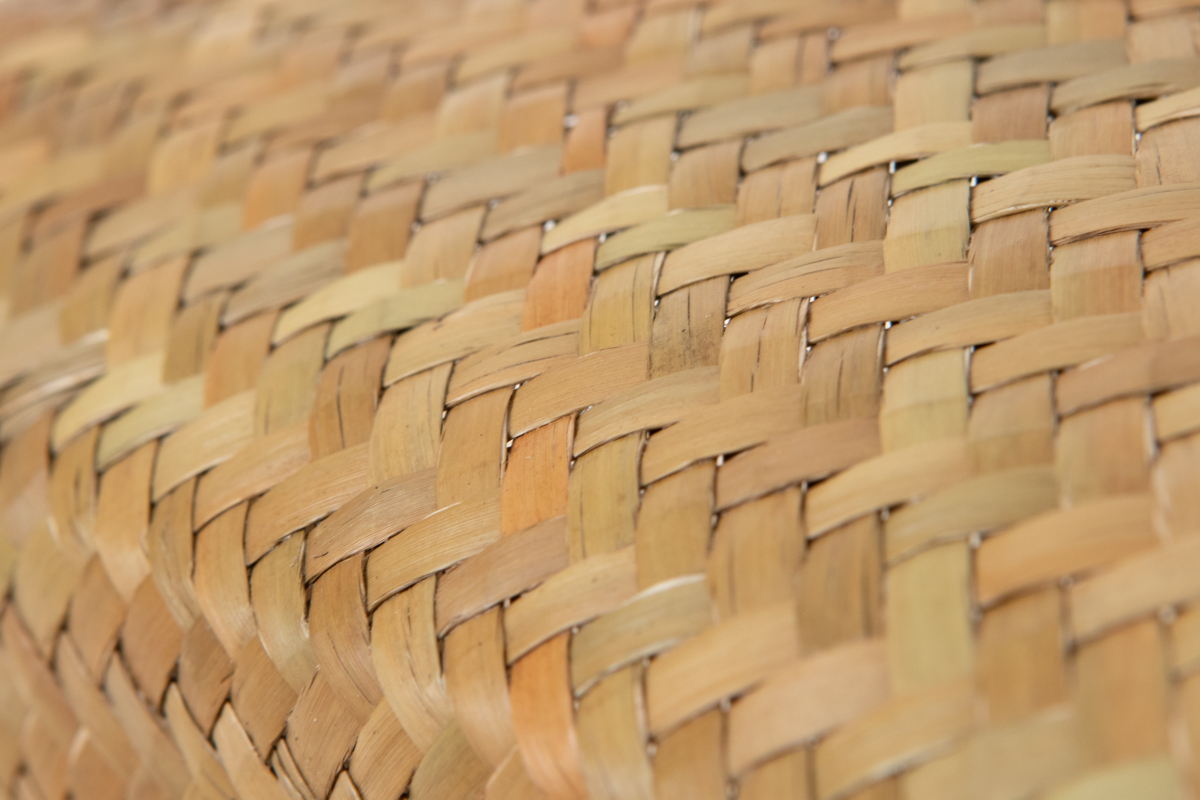
また、かご作りの最後の工程として、かご表面全体に糊付けをします。こちらもカチューのかご作りにおいては欠かせない、丈夫なかご作りのための工程であるとのこと。 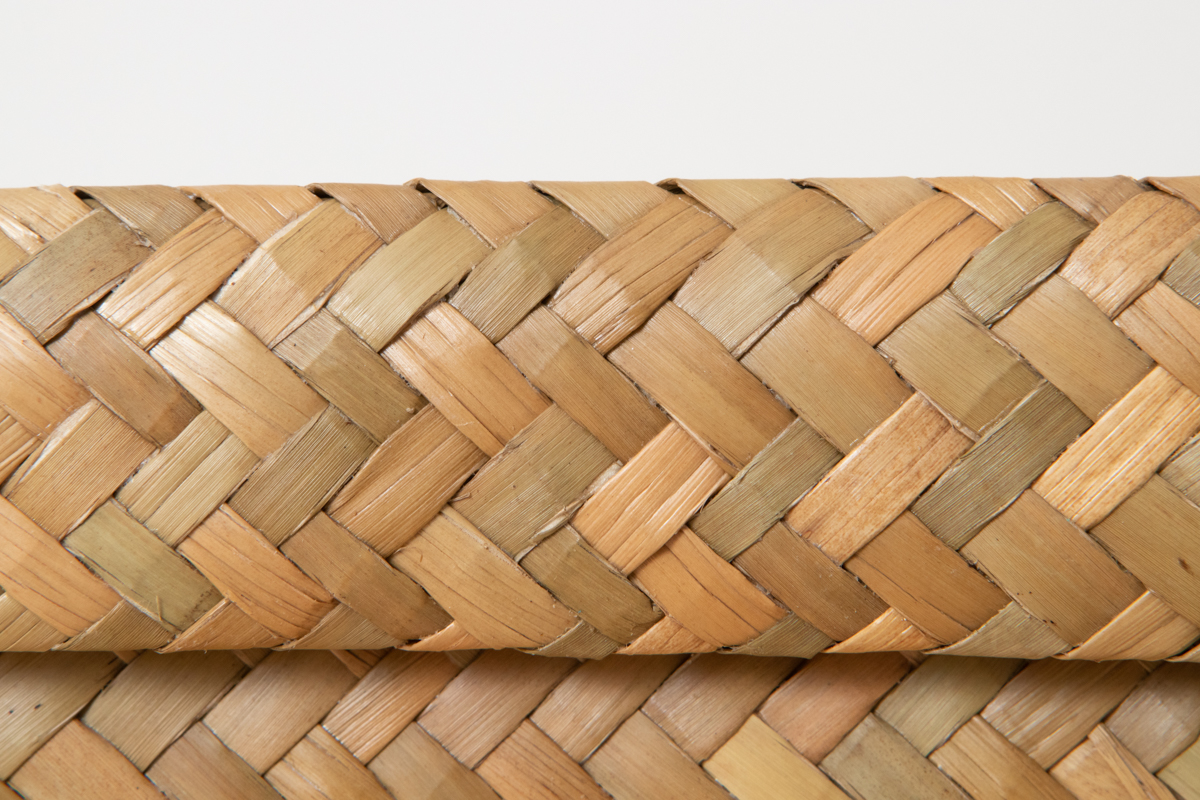
ござ状のものをかごに成形したのち、この縁部分を外側に折り返してしまい込んでいます。縁部分の仕上がりがかご全体の強度、品質を決めるため、特に重要な作業となります。 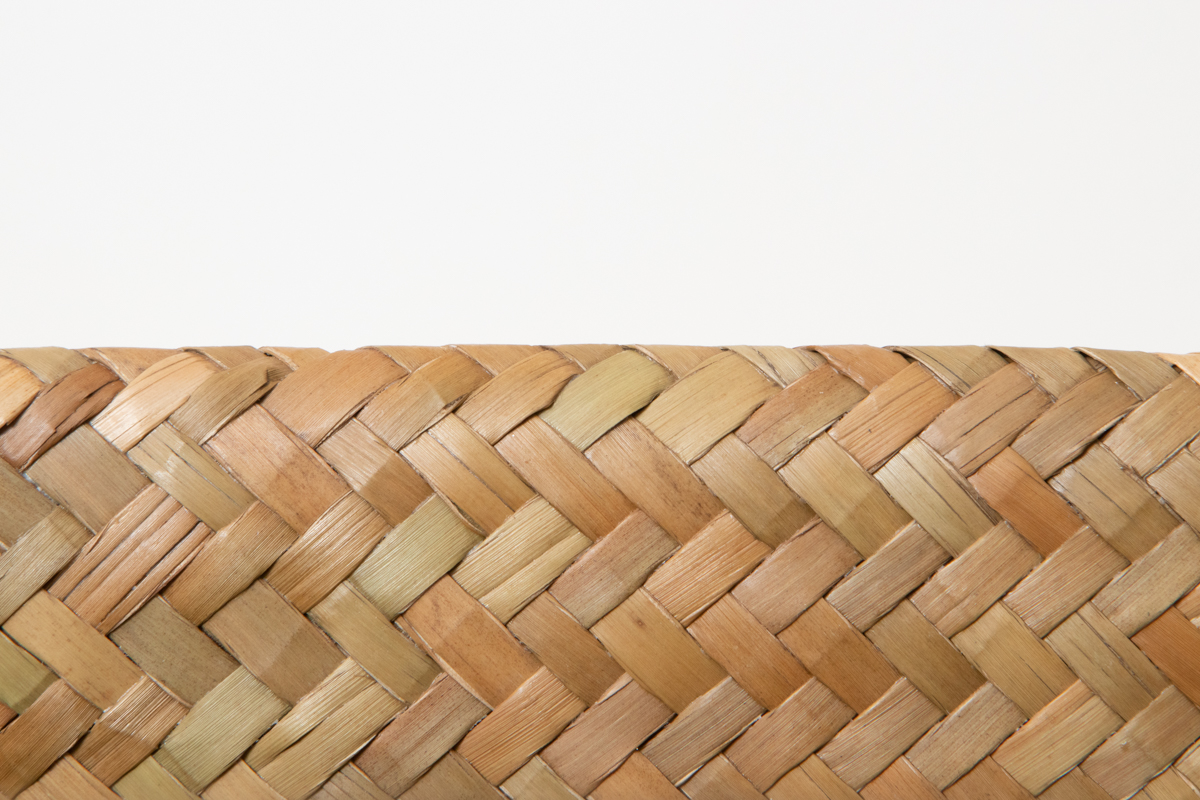
かごの内側から見た縁部分です。かっちりと固定され、整った仕上がりです。 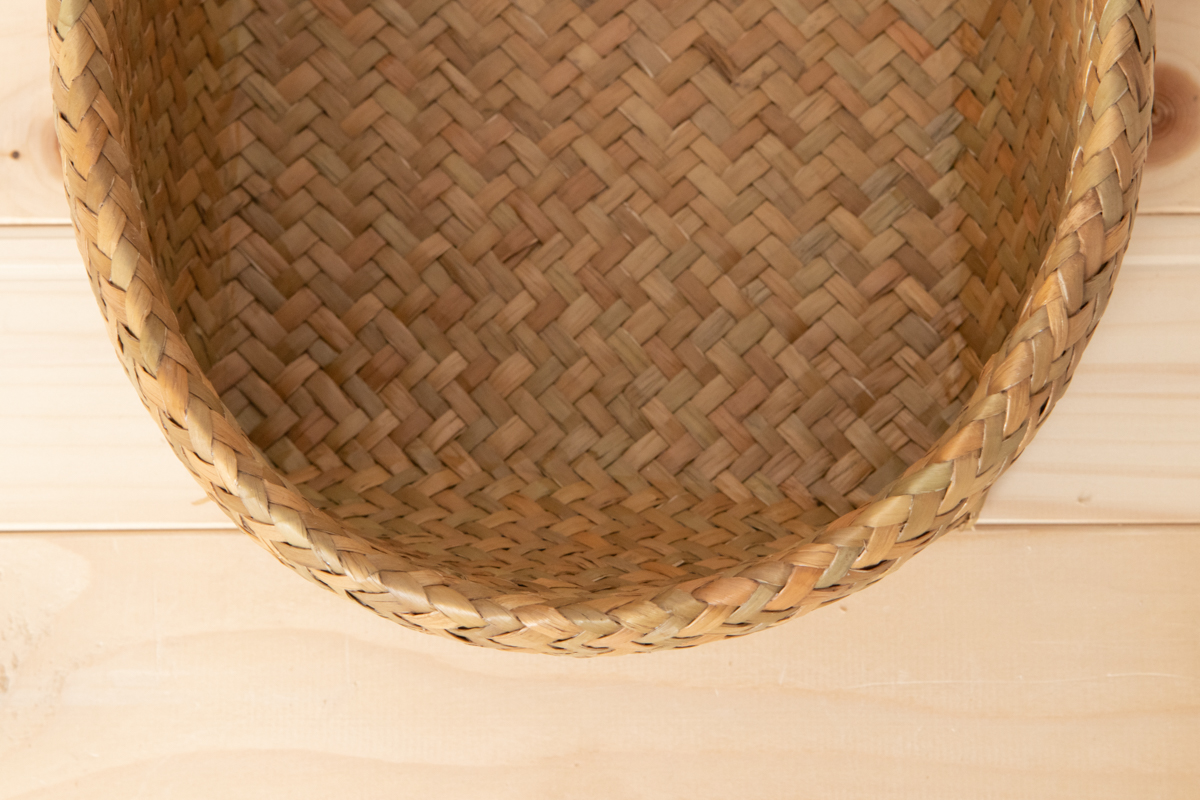
上からみた縁部分です。くっきりとした弧を描いています。 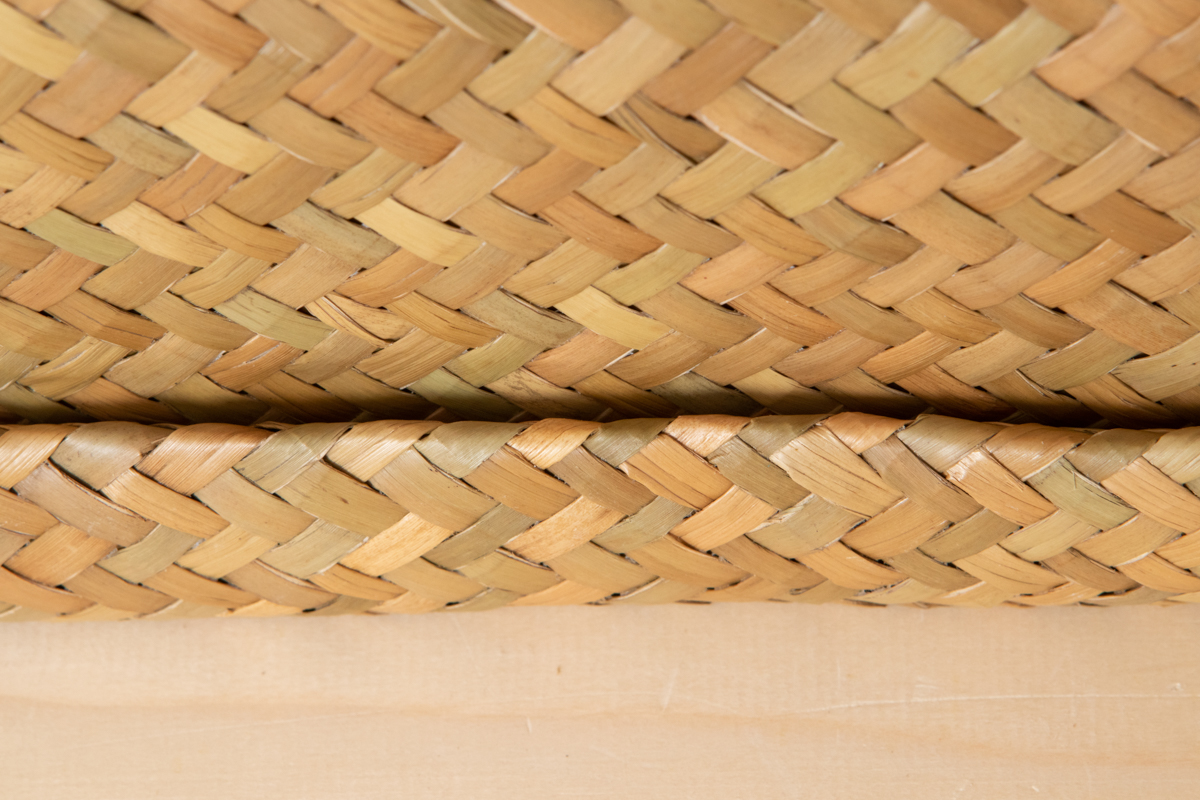
かごを上下逆さにして、縁の部分を上から撮ったところです。縁は折り返してかごの側面にぴったりとしまい込まれています。 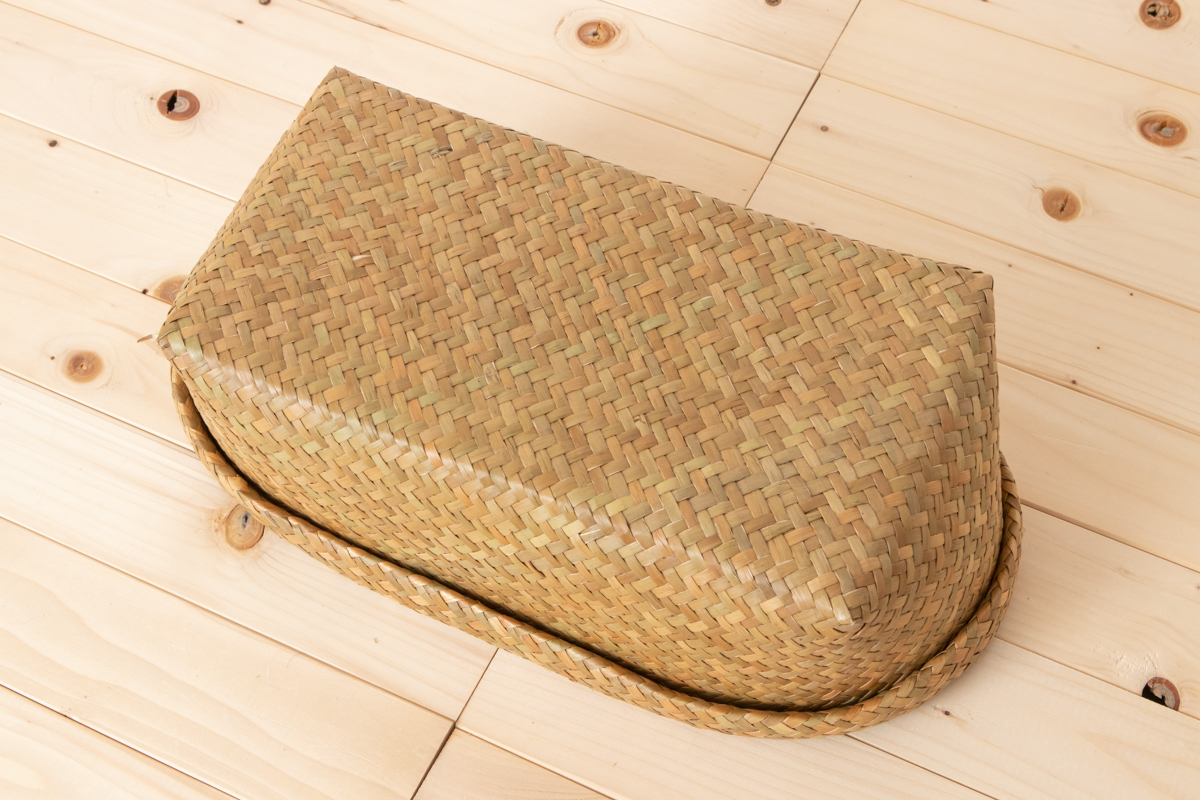
かごの底面裏側です。口は楕円形ですが、底面は長方形となっています。 
かご底面の角部分です。 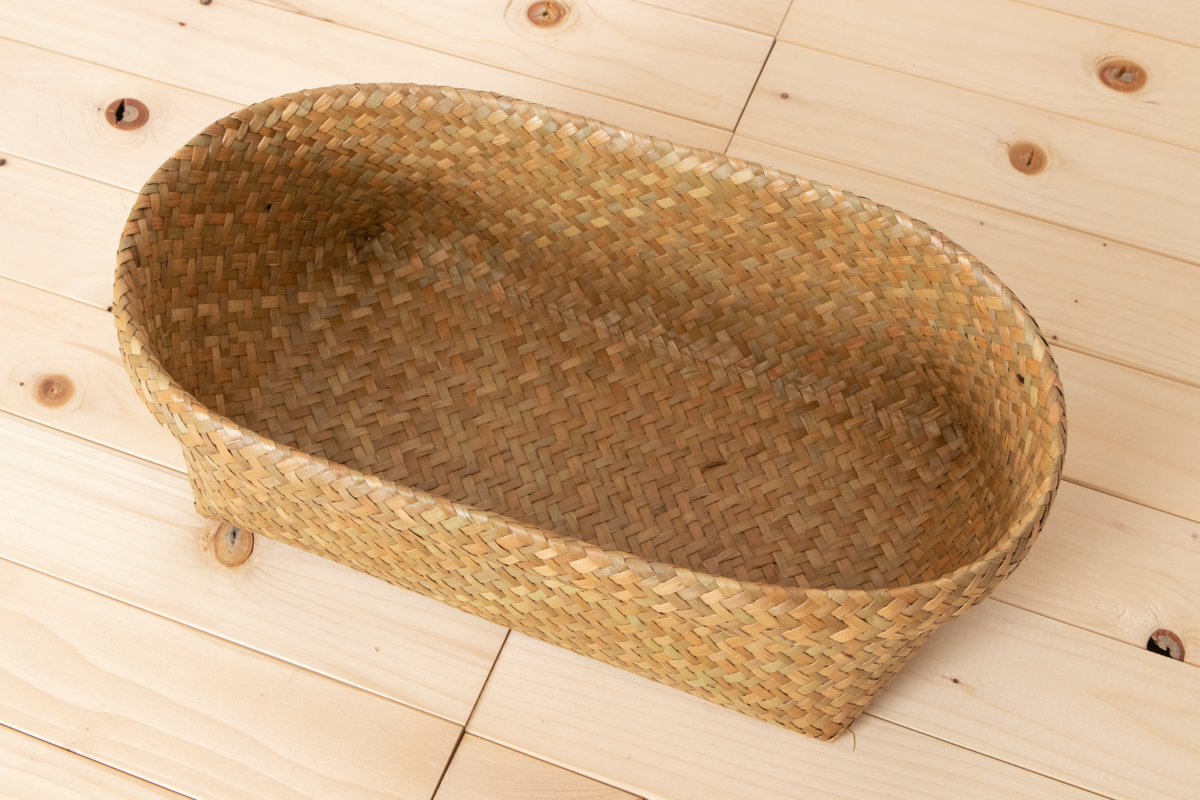
かごの膨らみがあまりないため、長四角のかごのようにデッドスペースなく収納できます。 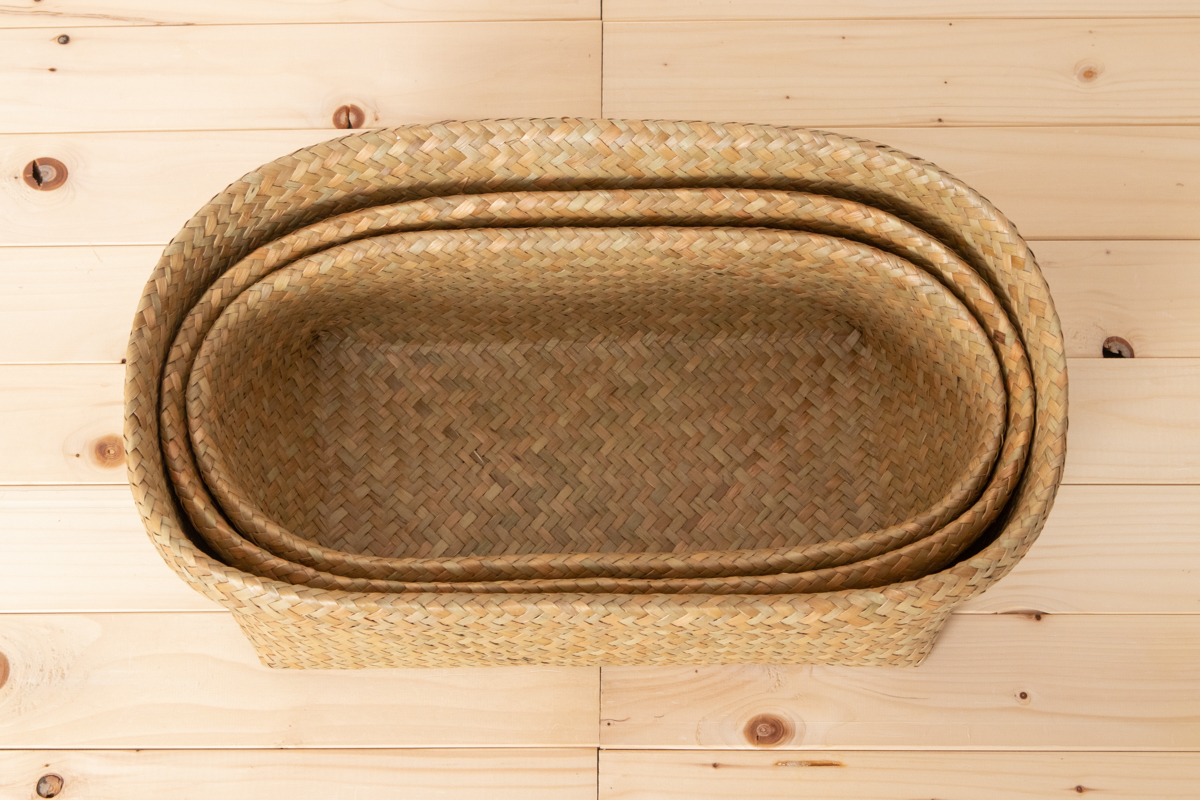
3サイズはこのように入れ子になります。それでは、サイズごとにご紹介します。 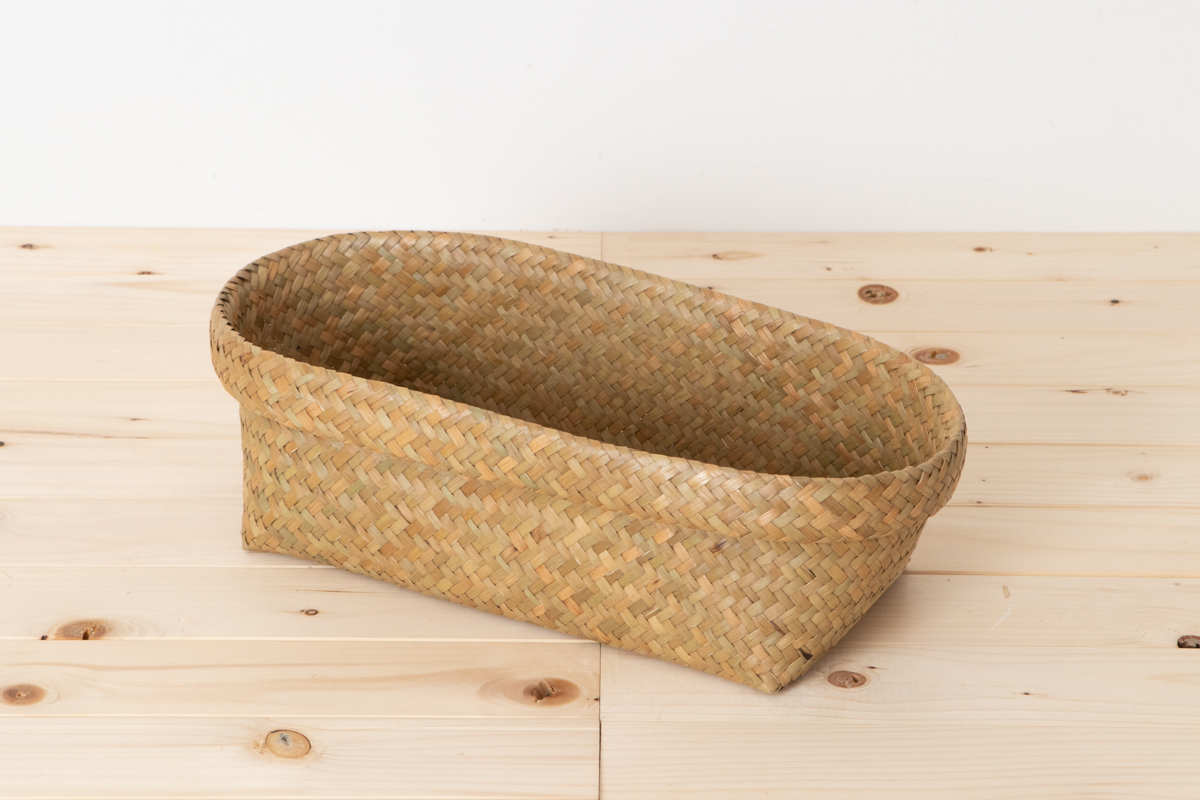
こちらはSサイズです。 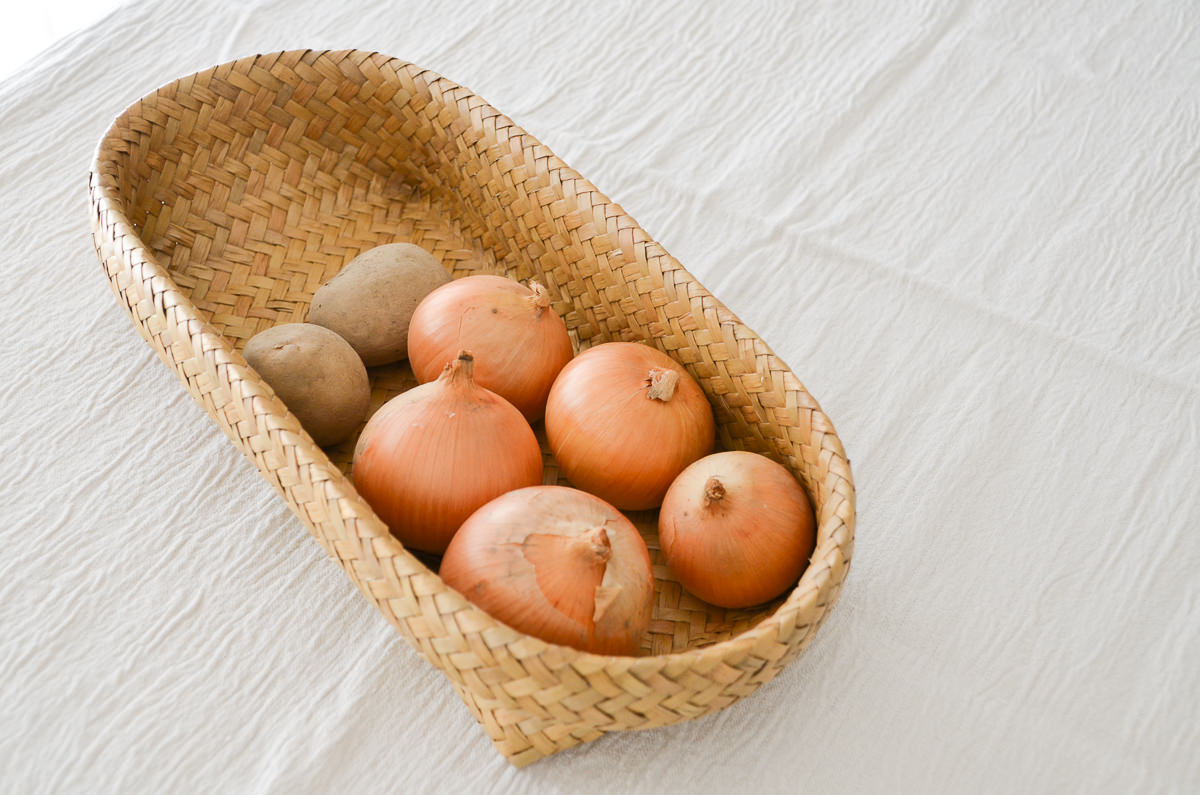
玉ねぎやじゃがいもなどの根菜をごろっと入れて。 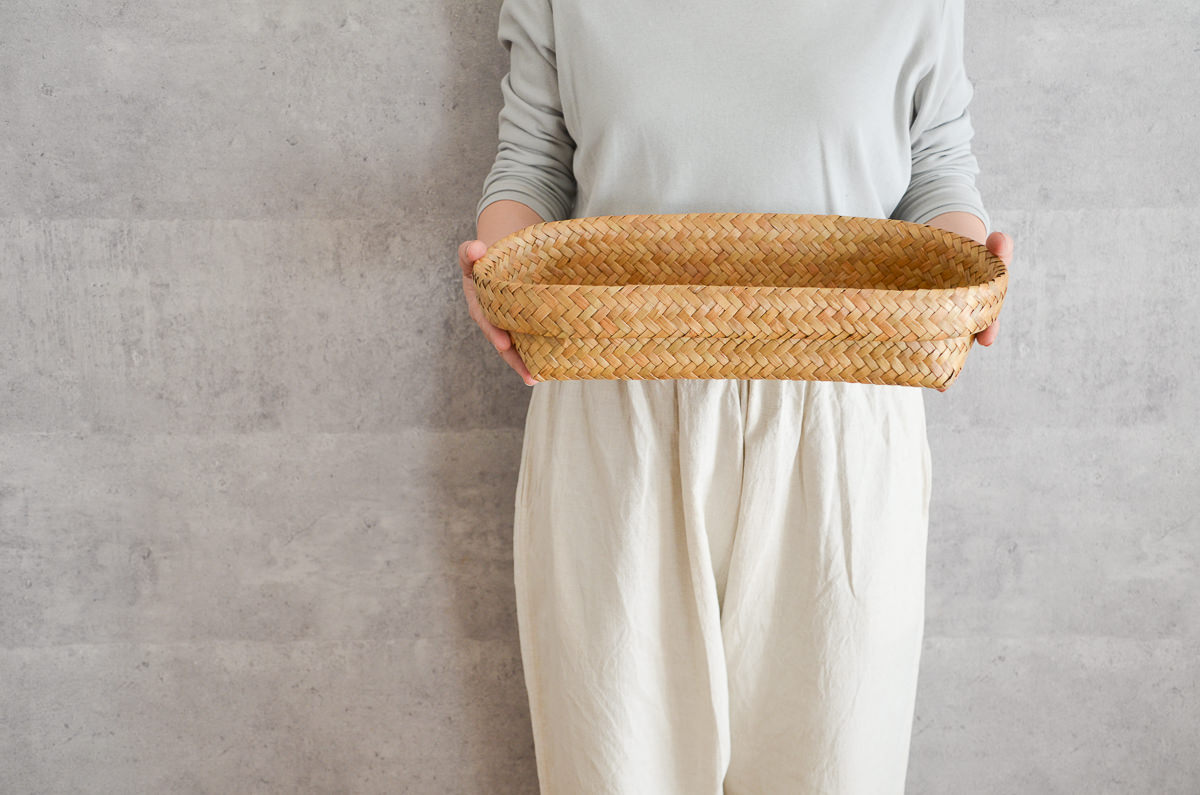
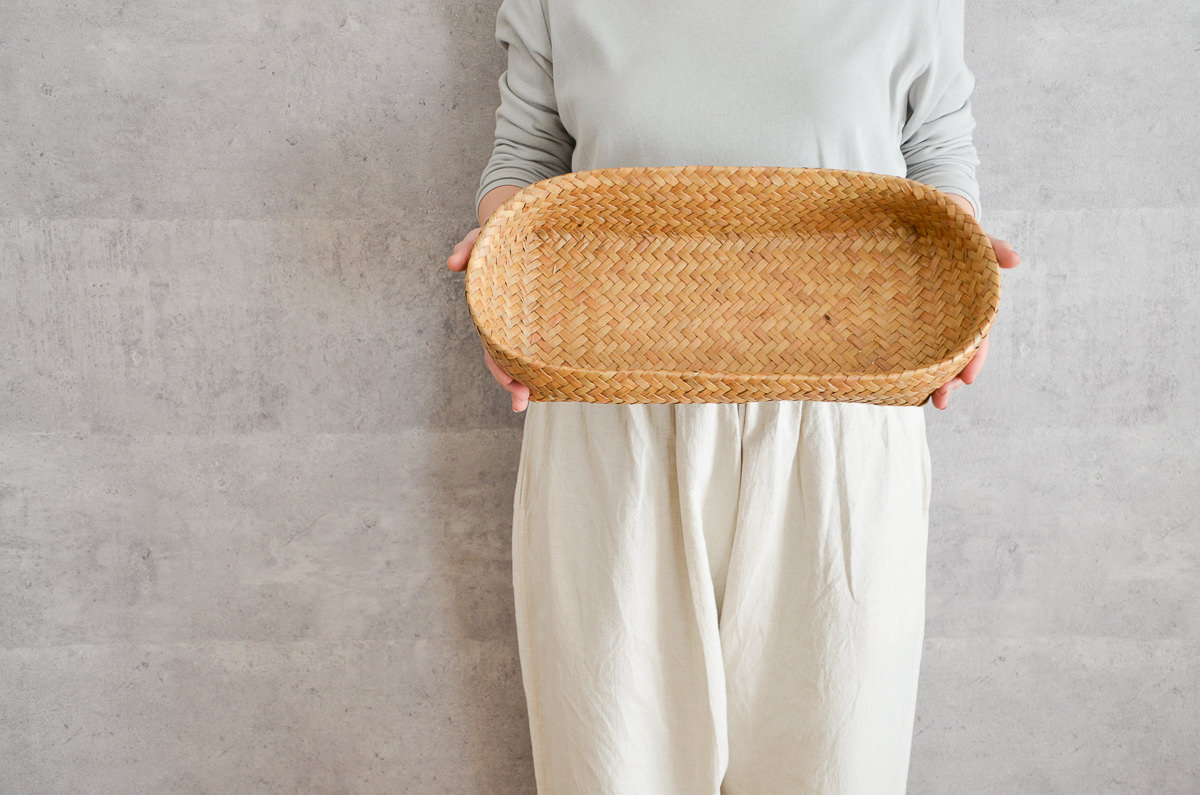
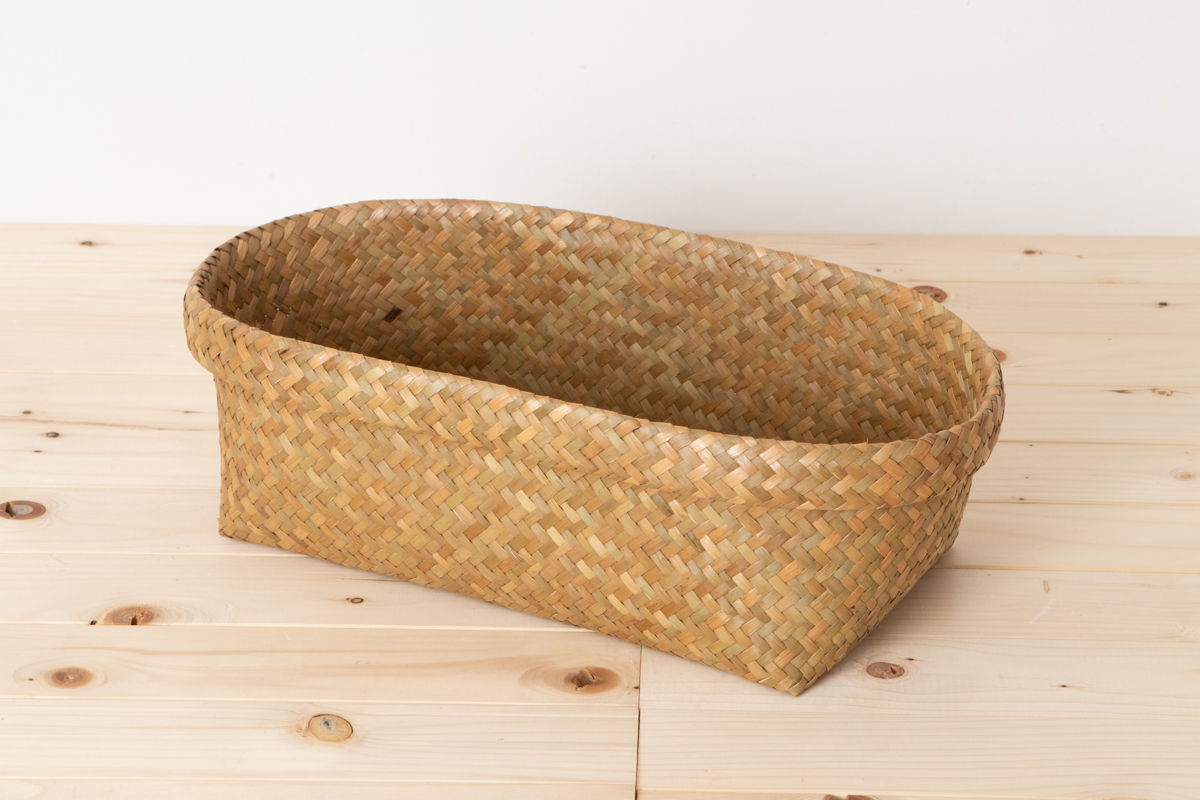
こちらはMサイズです。 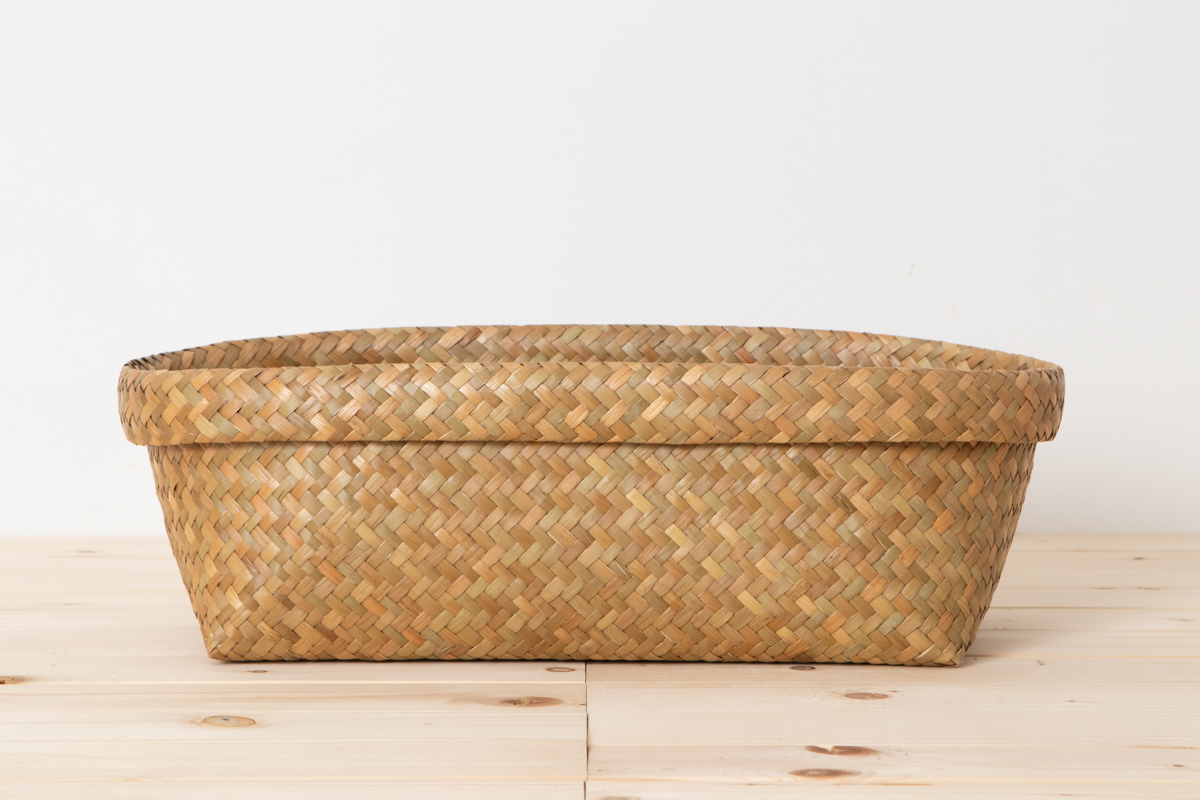
おもちゃ入れ、道具入れとしても。 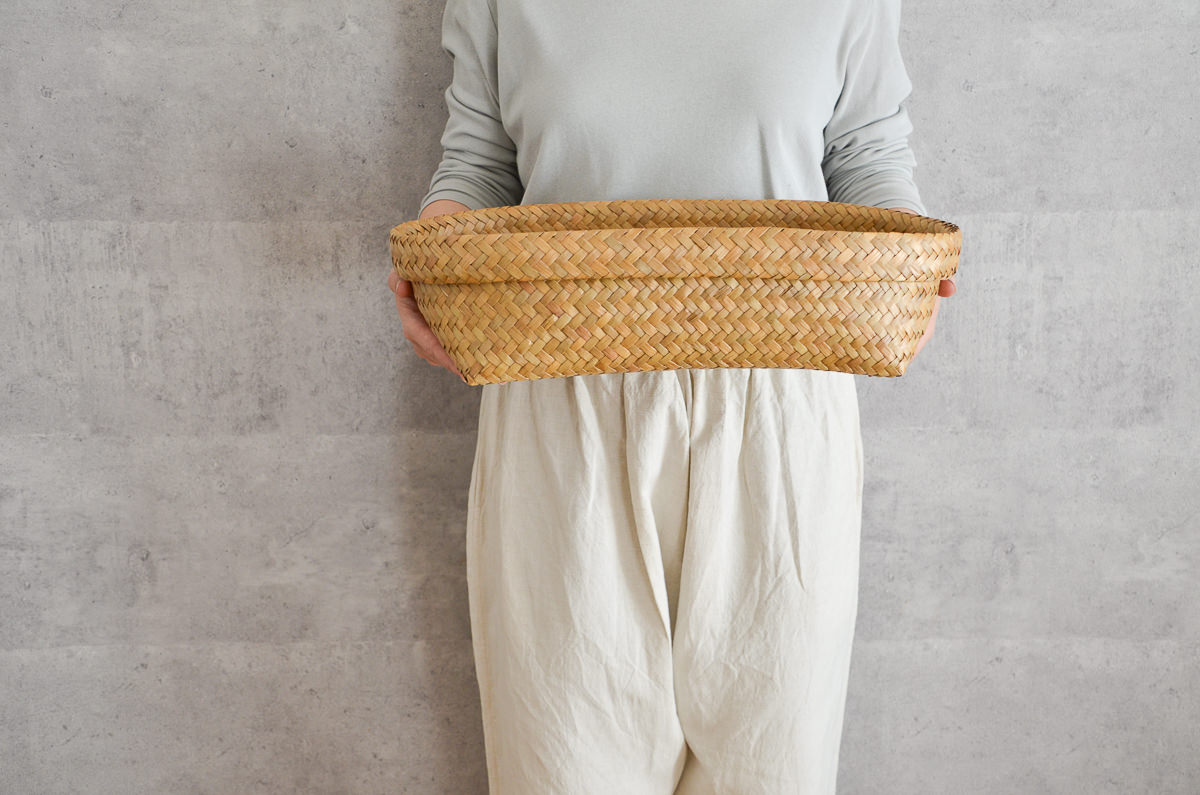

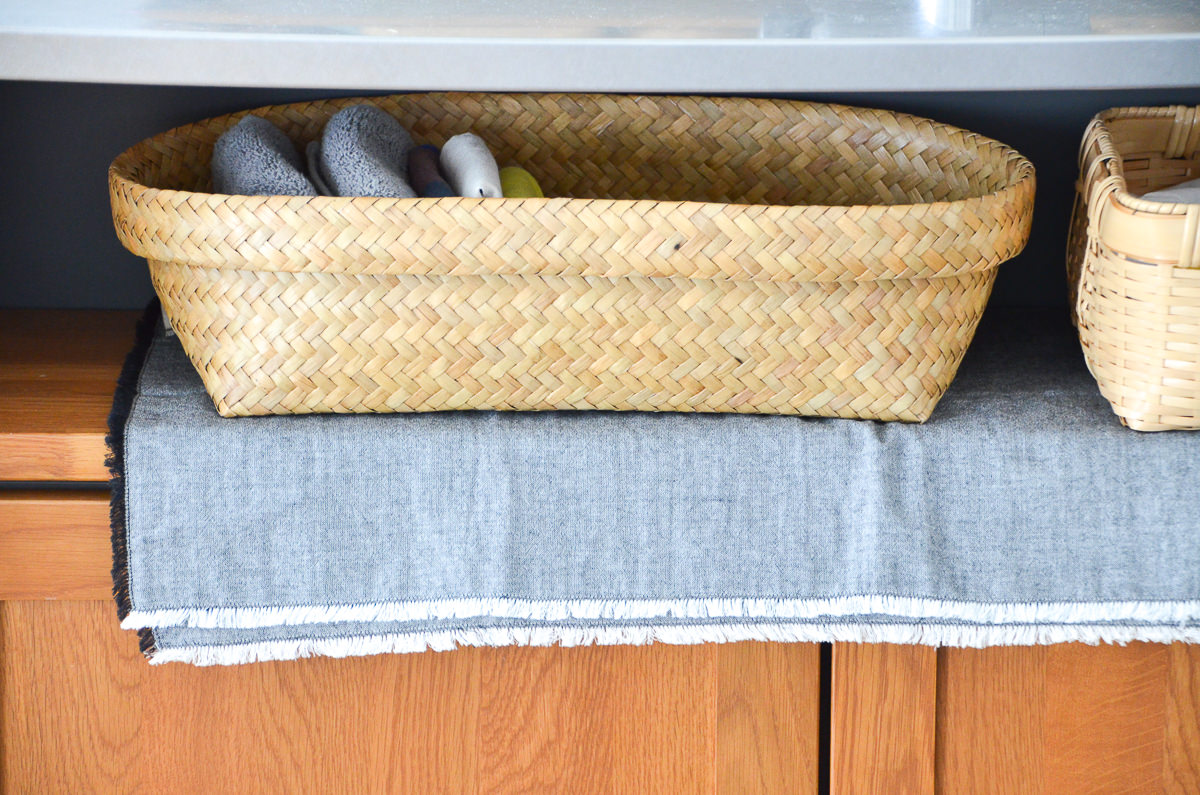
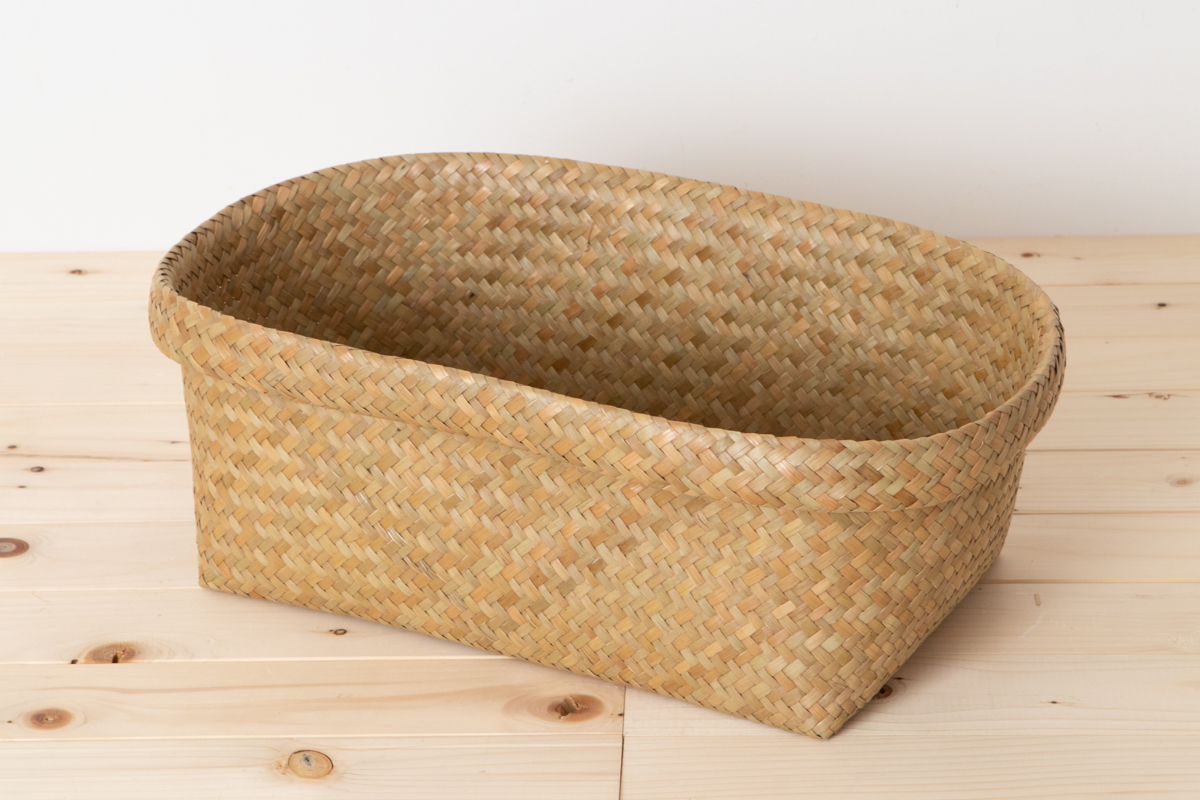
こちらはLサイズです。 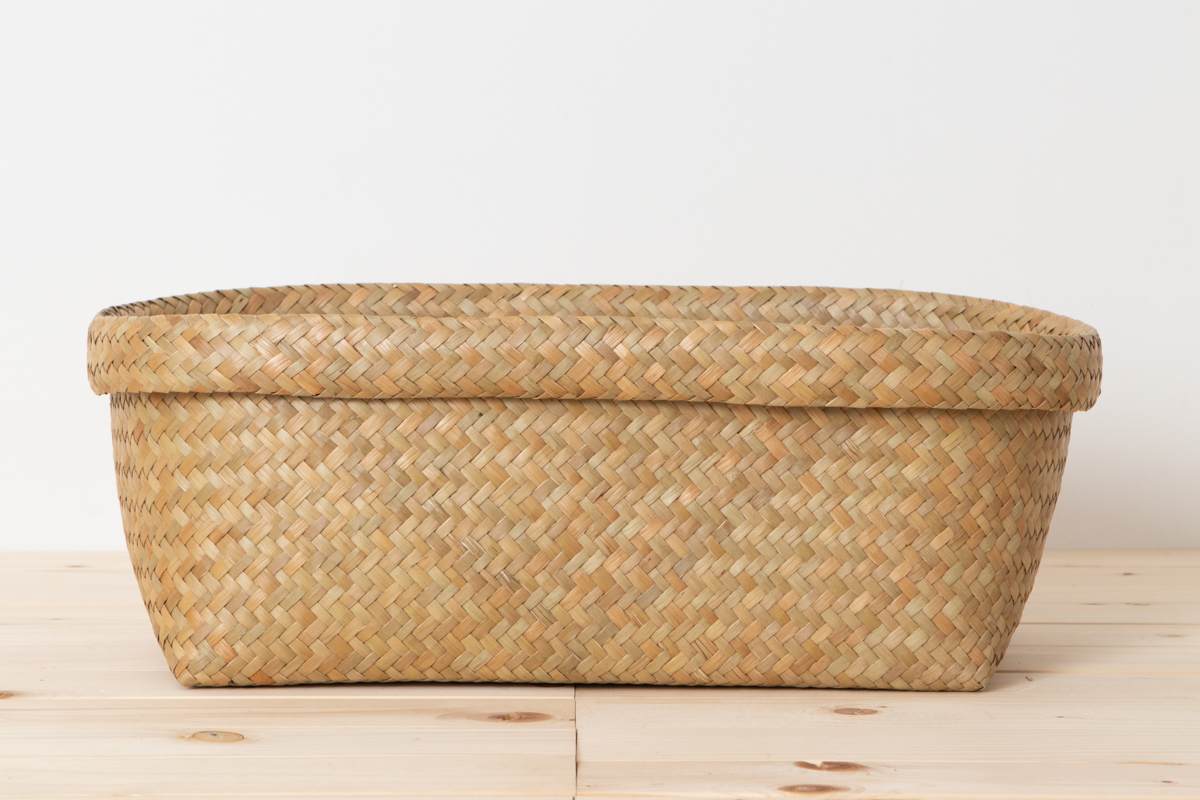
バッグや鞄入れ、来客用の荷物入れとしても良いと思います。 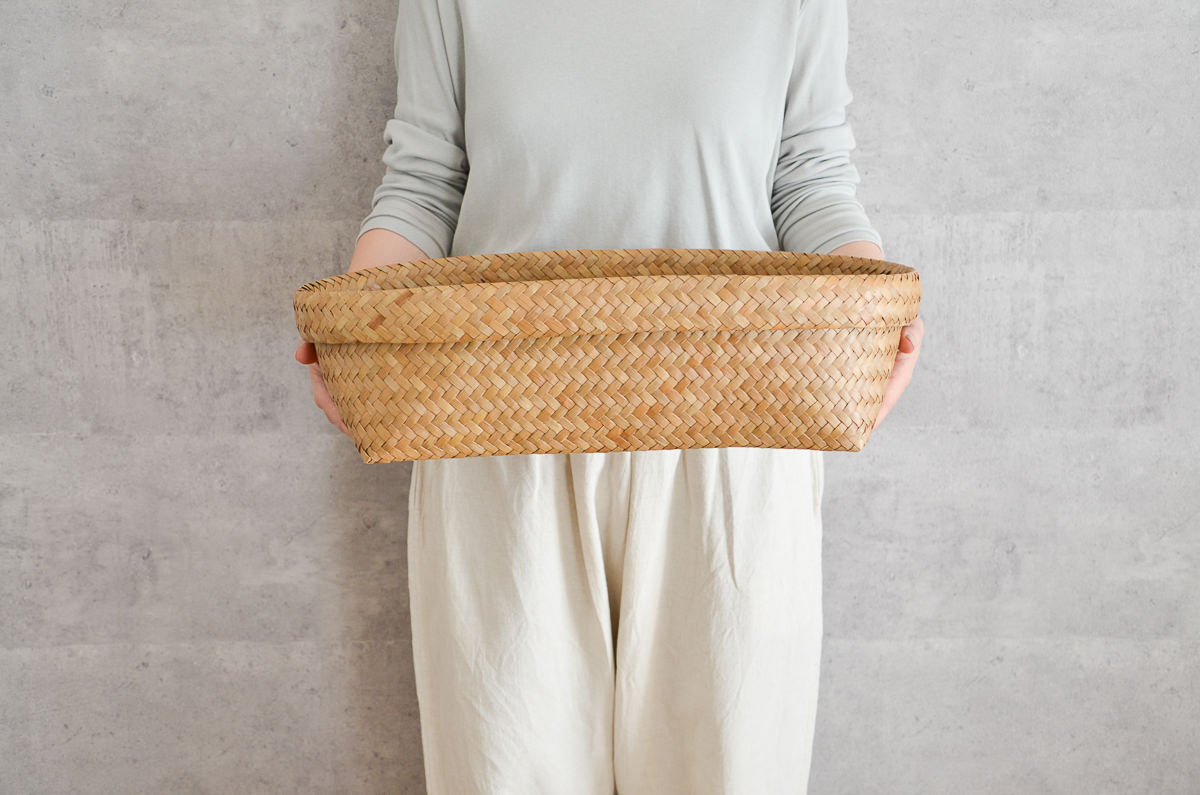

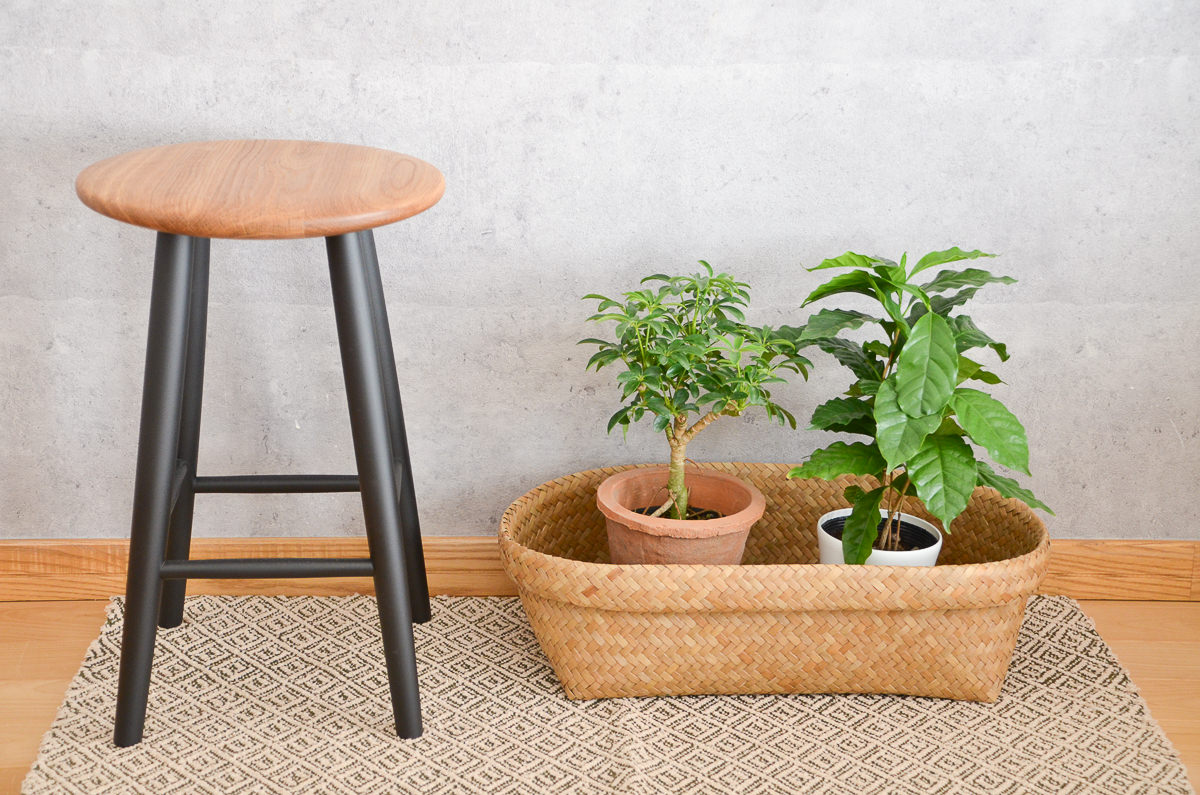
プランター、観葉植物を並べて置くのにもちょうど良いサイズです。
カチューのかご表面に塗られた糊は、形崩れを防ぎ、
日用品としてのかごの強度を増すための必要な加工であり、
いかに丈夫なかごを作るかを常に考えている作り手の方の知恵でもあります。
糊はよく乾燥させてありますが、ごくまれに肌の敏感な方が触れることで
赤みなどの反応が出ることもございます。
気になる方はかごの中に一枚布や紙を敷くなどして
ご使用になるのもよいかもしれません。


収納力がありながらもスリムな楕円形かご。
形崩れせず、床置きでも棚に置いても使える整理かごは
さまざまなシーンで活躍することと思います。
サイズをよくご確認の上、
いずれかお好みの大きさをお選びください。

<タイ・カチュー(水草)細工について>
気候でいうと、一年が雨季と乾季に分けられる熱帯気候に属するタイ。
タイの国土は象の顔に似ていると言われることがありますが、
その「鼻」部分にあたるマレー半島。
そこに位置するタイ南部は少し気候が異なり、季節により南西(太平洋方面)から、
または北東(インド洋方面)から吹く季節風(モンスーン)の影響で
他の地域に比べて雨の降る時期が長く、乾季が約2か月のみと短いのが特徴です。
「カチュー」はその高温多湿の環境にあるタイ南部の沼地に生息する草の名前で、
現地の人たちはタイ語でそのように呼んでいます。
雨量の多いタイでは洪水が起こることも多く、
そのために年によってはカチューが流されたり傷んだりして、不作となることもあります。
タイ国内外でカチューのかご需要が高まっている中、
かご作りのための材料確保は作り手の方々にとって悩ましい問題ともなっています。
こちらでご紹介する「カチュー細工」は主にマレー半島東側の
タイ湾に面したスゥラターニー、ナコーンスィータマラー、
パッターニー、ナラーティワーなどの県で作られたものです。

こちらはタイ語で「カチュー」と呼ばれる沼地周辺に自生する草で
編まれたかごです。
茎の部分を根から切り取り、乾燥させて平たくした状態のものを編み込んでいきます。茎は春(5月ごろ)から夏(8月ごろ)にかけて収穫されます。
大きいサイズのかごには長めの茎が必要とされるため、
少し収穫を遅らせてさらに成長するのを待ってから刈り採ることもあります。
作り手は地域により異なりますが、編む技術に長けた人が先生となり周りの人に指導しながら製作するグループや、家族3世代で編む人たちなど。
村ごとにだいたい4〜5人のグループで作られていることが多いようです。
ほとんどの方にとってかご作りは専業ではなく、稲作など農業の合間に作られることが多く、編み手は高齢世代が多いのが現状です。
若い世代の編み手が少ないながらも、今、改めてタイ国内でも、こうした自然素材製品の良さが見直され、若い人たちがかごを手に取るようになってきているとのこと。
こちらのページでは、「カチュー」製、楕円型の整理かご
「S、M、L」3サイズをご紹介します。



























カチューのかご表面に塗られた糊は、形崩れを防ぎ、
日用品としてのかごの強度を増すための必要な加工であり、
いかに丈夫なかごを作るかを常に考えている作り手の方の知恵でもあります。
糊はよく乾燥させてありますが、ごくまれに肌の敏感な方が触れることで
赤みなどの反応が出ることもございます。
気になる方はかごの中に一枚布や紙を敷くなどして
ご使用になるのもよいかもしれません。


収納力がありながらもスリムな楕円形かご。
形崩れせず、床置きでも棚に置いても使える整理かごは
さまざまなシーンで活躍することと思います。
サイズをよくご確認の上、
いずれかお好みの大きさをお選びください。

<タイ・カチュー(水草)細工について>
気候でいうと、一年が雨季と乾季に分けられる熱帯気候に属するタイ。
タイの国土は象の顔に似ていると言われることがありますが、
その「鼻」部分にあたるマレー半島。
そこに位置するタイ南部は少し気候が異なり、季節により南西(太平洋方面)から、
または北東(インド洋方面)から吹く季節風(モンスーン)の影響で
他の地域に比べて雨の降る時期が長く、乾季が約2か月のみと短いのが特徴です。
「カチュー」はその高温多湿の環境にあるタイ南部の沼地に生息する草の名前で、
現地の人たちはタイ語でそのように呼んでいます。
雨量の多いタイでは洪水が起こることも多く、
そのために年によってはカチューが流されたり傷んだりして、不作となることもあります。
タイ国内外でカチューのかご需要が高まっている中、
かご作りのための材料確保は作り手の方々にとって悩ましい問題ともなっています。
こちらでご紹介する「カチュー細工」は主にマレー半島東側の
タイ湾に面したスゥラターニー、ナコーンスィータマラー、
パッターニー、ナラーティワーなどの県で作られたものです。

こちらはタイ語で「カチュー」と呼ばれる沼地周辺に自生する草で
編まれたかごです。
茎の部分を根から切り取り、乾燥させて平たくした状態のものを編み込んでいきます。茎は春(5月ごろ)から夏(8月ごろ)にかけて収穫されます。
大きいサイズのかごには長めの茎が必要とされるため、
少し収穫を遅らせてさらに成長するのを待ってから刈り採ることもあります。
作り手は地域により異なりますが、編む技術に長けた人が先生となり周りの人に指導しながら製作するグループや、家族3世代で編む人たちなど。
村ごとにだいたい4〜5人のグループで作られていることが多いようです。
ほとんどの方にとってかご作りは専業ではなく、稲作など農業の合間に作られることが多く、編み手は高齢世代が多いのが現状です。
若い世代の編み手が少ないながらも、今、改めてタイ国内でも、こうした自然素材製品の良さが見直され、若い人たちがかごを手に取るようになってきているとのこと。
こちらのページでは、「カチュー」製、楕円型の整理かご
「S、M、L」3サイズをご紹介します。


かご側面の編み目は、日本で「あじろ編み」と呼ばれる編み方と同じです。 
平たくした茎を交互に編み組んでいき、一枚の「ござ」ぐらいの大きさに仕上げたものを、かごの形に成形していきます。 
水辺から伐り採ったカチューの茎は、粘土質の泥を塗り込んで3〜5日ほど天日干しされます。そうすることで、素材に粘りと湿り気を持たせて乾燥による割れを防ぐことができ、素材としての強度が増すとのこと。 
また、かご作りの最後の工程として、かご表面全体に糊付けをします。こちらもカチューのかご作りにおいては欠かせない、丈夫なかご作りのための工程であるとのこと。 
ござ状のものをかごに成形したのち、この縁部分を外側に折り返してしまい込んでいます。縁部分の仕上がりがかご全体の強度、品質を決めるため、特に重要な作業となります。 
かごの内側から見た縁部分です。かっちりと固定され、整った仕上がりです。 
上からみた縁部分です。くっきりとした弧を描いています。 
かごを上下逆さにして、縁の部分を上から撮ったところです。縁は折り返してかごの側面にぴったりとしまい込まれています。 
かごの底面裏側です。口は楕円形ですが、底面は長方形となっています。 
かご底面の角部分です。 
かごの膨らみがあまりないため、長四角のかごのようにデッドスペースなく収納できます。 
3サイズはこのように入れ子になります。それでは、サイズごとにご紹介します。 
こちらはSサイズです。 
玉ねぎやじゃがいもなどの根菜をごろっと入れて。 


こちらはMサイズです。 
おもちゃ入れ、道具入れとしても。 



こちらはLサイズです。 
バッグや鞄入れ、来客用の荷物入れとしても良いと思います。 


プランター、観葉植物を並べて置くのにもちょうど良いサイズです。
カチューのかご表面に塗られた糊は、形崩れを防ぎ、
日用品としてのかごの強度を増すための必要な加工であり、
いかに丈夫なかごを作るかを常に考えている作り手の方の知恵でもあります。
糊はよく乾燥させてありますが、ごくまれに肌の敏感な方が触れることで
赤みなどの反応が出ることもございます。
気になる方はかごの中に一枚布や紙を敷くなどして
ご使用になるのもよいかもしれません。


収納力がありながらもスリムな楕円形かご。
形崩れせず、床置きでも棚に置いても使える整理かごは
さまざまなシーンで活躍することと思います。
サイズをよくご確認の上、
いずれかお好みの大きさをお選びください。

<タイ・カチュー(水草)細工について>
気候でいうと、一年が雨季と乾季に分けられる熱帯気候に属するタイ。
タイの国土は象の顔に似ていると言われることがありますが、
その「鼻」部分にあたるマレー半島。
そこに位置するタイ南部は少し気候が異なり、季節により南西(太平洋方面)から、
または北東(インド洋方面)から吹く季節風(モンスーン)の影響で
他の地域に比べて雨の降る時期が長く、乾季が約2か月のみと短いのが特徴です。
「カチュー」はその高温多湿の環境にあるタイ南部の沼地に生息する草の名前で、
現地の人たちはタイ語でそのように呼んでいます。
雨量の多いタイでは洪水が起こることも多く、
そのために年によってはカチューが流されたり傷んだりして、不作となることもあります。
タイ国内外でカチューのかご需要が高まっている中、
かご作りのための材料確保は作り手の方々にとって悩ましい問題ともなっています。
こちらでご紹介する「カチュー細工」は主にマレー半島東側の
タイ湾に面したスゥラターニー、ナコーンスィータマラー、
パッターニー、ナラーティワーなどの県で作られたものです。





